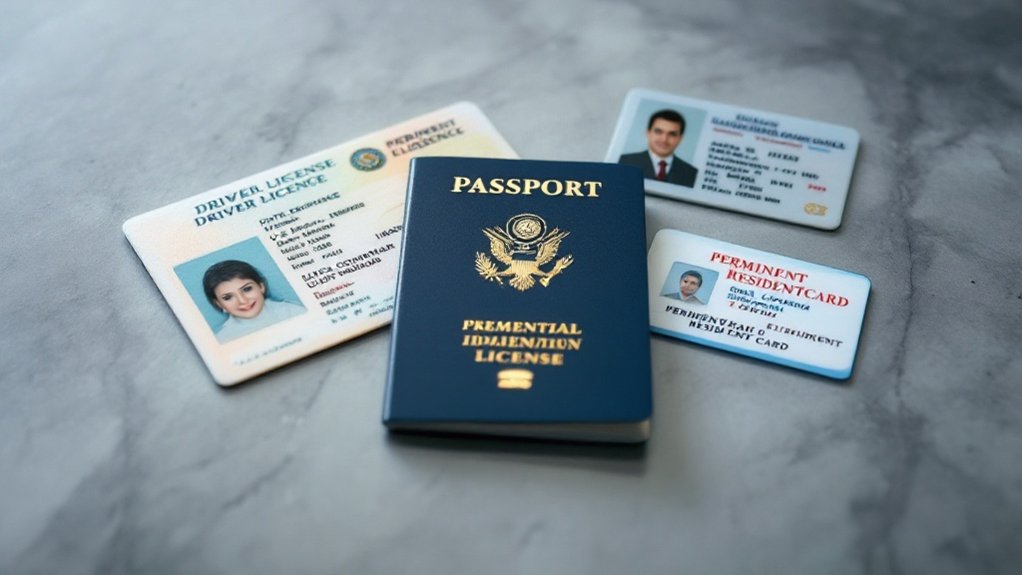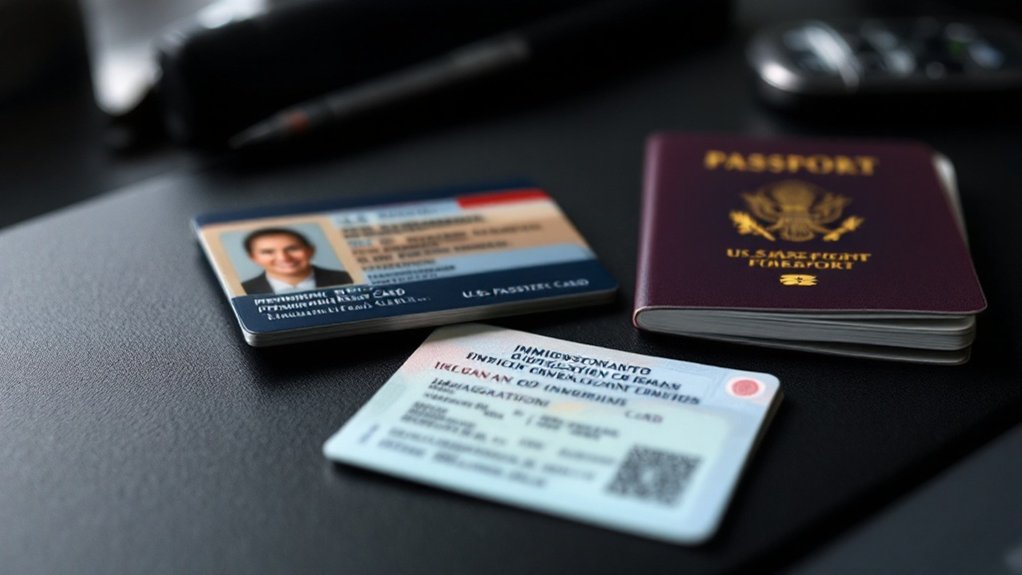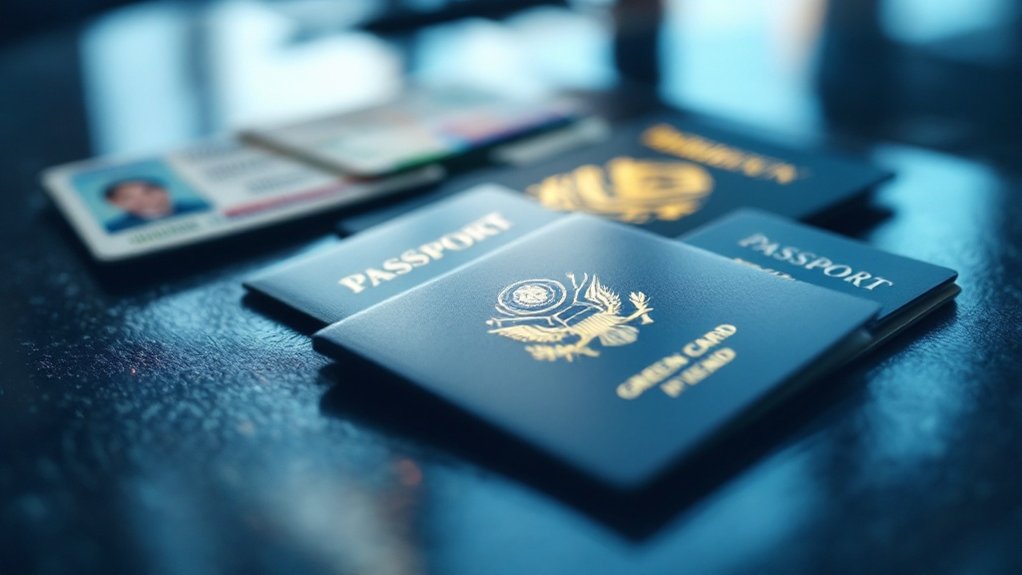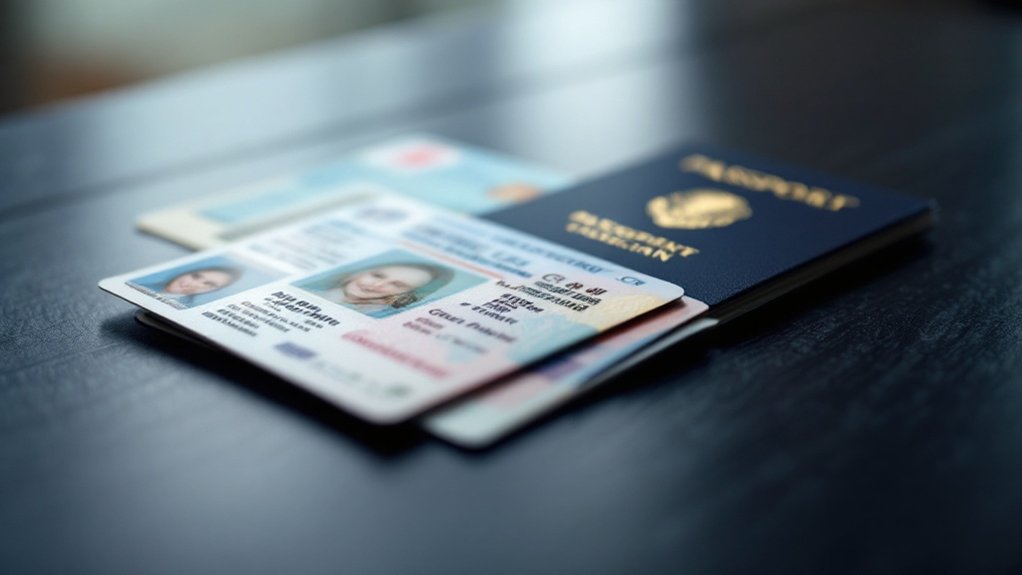For Live Scan fingerprinting, you’ll need a primary form of ID like a state-issued driver’s license, U.S. passport, or Uniformed Services Identification Card. If you don’t have these, secondary IDs like a birth certificate or military ID can be used with additional supporting documents. Non-US citizens may require different procedures. Military and government personnel can use specific ID cards. If you’re interested in more details on state-specific requirements and verification processes, you can explore further.
Primary Forms of Identification

When preparing for Live Scan fingerprinting, you’ll need to bring a valid primary form of identification. Common primary IDs include a state-issued driver’s license, a U.S. passport or passport card, and a Uniformed Services Identification Card for military personnel. Other accepted IDs are the Federal Government Personal Identity Verification Card and the Department of Defense Common Access Card. These documents must be valid and contain your photo, name, and other identifying information. They serve as proof of your identity and are essential for the Live Scan process.
Secondary Forms of Identification
In preparing for Live Scan fingerprinting, you may need to provide secondary forms of identification if you don’t have a primary ID. Acceptable secondary forms include a State Government Issued Certificate of Birth, U.S. Active Duty/Retiree/Reservist Military Identification Card, and a U.S. Passport. Other options are the Federal Government Personal Identity Verification Card (PIV) and the Department of Defense Common Access Card.
Additional secondary identification options include a U.S. Tribal or Bureau of Indian Affairs Identification Card, Social Security Card, and government-issued certificates like marriage or court orders. Supplemental documents such as a utility bill or paycheck stub may also be required to support these IDs.
Special Considerations for Non-US Citizens

How do non-US citizens navigate the fingerprinting process for immigration purposes? Non-US citizens typically cannot use Livescan methods and must rely on hardcopy fingerprint cards. These cards are vital for background checks, which are essential for immigration and visa applications. The FBI processes these fingerprints to verify criminal records.
Fingerprint Capture: Must be done by law enforcement or trained individuals.
Card Specifications: Cards must be completed in black or dark blue ink.
Information Required: Detailed personal information is needed.
Authorized Centers: Fingerprinting must be done at authorized centers.
Privacy Rights: Applicants have specific privacy rights regarding their fingerprints.
Military and Government ID Options
Non-US citizens often rely on manual fingerprint cards for immigration purposes, but for those eligible for Live Scan, understanding the accepted forms of identification is essential. You can use a US Active Duty/Retiree/Reservist Military ID Card as a valid form of identification for Live Scan fingerprinting. Other government IDs accepted include the Federal Government Personal Identity Verification Card (PIV) and the Department of Defense Common Access Card. Additionally, Uniformed Services Identification Cards and federal, state, or local government agency ID cards with photographs are recognized. These IDs are verified to ascertain validity and compliance with regulations, incorporating advanced security features to prevent fraud.
State-Specific ID Requirements

When you’re preparing for a Live Scan fingerprinting appointment, it is crucial to understand the specific ID requirements for your state. Each state has its own set of rules and accepted forms of identification. For instance, in California, you need a valid photo ID like a driver’s license or state ID, while in Florida, a government-issued photo ID is required. Additionally, during the Live Scan process, your personal information is inputted into the system, which includes providing a valid form of identification, such as a driver’s license, to ensure accurate identity verification.
- California: Accepts driver’s licenses and state IDs.
- Florida: Requires a valid government-issued photo ID.
- Colorado: Similar to California, accepts driver’s licenses and state IDs.
- Alabama: Uses AAPS for electronic submissions, no live scan.
- Arkansas: Requires electronic submissions for residents.
Verification Process for ID Documents
The verification process for ID documents during Live Scan fingerprinting is a critical step that affirms the accurate association of fingerprints with the correct individual. You will typically need to present a valid government-issued ID, such as a driver’s license, passport, or state ID card. The verification process involves visually inspecting the ID to validate it is valid and unexpired, and confirming that your name and date of birth match.
During this process, your ID may be checked against a database or verified using digital tools. This validates compliance with regulations and prevents misidentification, enhancing the security and accuracy of the Live Scan process.
Common Issues With ID Verification**

When preparing for a Live Scan appointment, you must be aware of common issues with ID verification. Using an expired or invalid ID, failing to bring any government-issued ID, or having insufficient documentation can lead to delays or rescheduling. Additionally, inconsistencies between your ID and other documents may cause verification problems, emphasizing the importance of ensuring all information is accurate and complete before your appointment.
Common Issues With ID Verification
Common issues with ID verification during Live Scan fingerprinting often arise from incomplete or inaccurate information on identification documents. This can lead to delays or even rejection of your application. To avoid these issues, it’s essential to guarantee your IDs are valid and complete.
- Incomplete Information: Missing details on your ID can cause verification issues.
- Expired Documents: Using expired IDs can result in delays or rejection.
- Non-Standard IDs: Student IDs or other non-standard IDs may not be accepted.
- State-Specific Rules: Different states have unique ID requirements.
- Verification Process Errors: Incorrect validation by certified fingerprint rollers can lead to issues.
Properly verifying identification documents is crucial, as ID verification errors can lead to costly consequences and delays in the fingerprinting process.
ID Inconsistencies
ID inconsistencies during Live Scan fingerprinting can substantially hinder the process, often due to variations in what constitutes acceptable identification across different states. You may encounter issues if your ID doesn’t match local requirements, leading to delays or even rejection of your application. Supplemental documents like utility bills or voter registration cards may be needed to support secondary IDs, adding complexity to the verification process.
As you prepare for Live Scan fingerprinting, it is vital your IDs are valid and unexpired. Inconsistent acceptance of IDs across states can complicate matters, so it’s imperative to check local guidelines beforehand. Proper verification of IDs by certified personnel is essential to avoid legal and security issues.
Conclusion
When undergoing live scan fingerprinting, you’ll need to present primary identification like a driver’s license or passport. Secondary options include birth certificates or Social Security cards, often requiring additional supporting documents. Some might object that these requirements are too stringent, but they safeguard accurate identity verification, which is essential for security and legal purposes. This process helps maintain the integrity of fingerprinting services.

